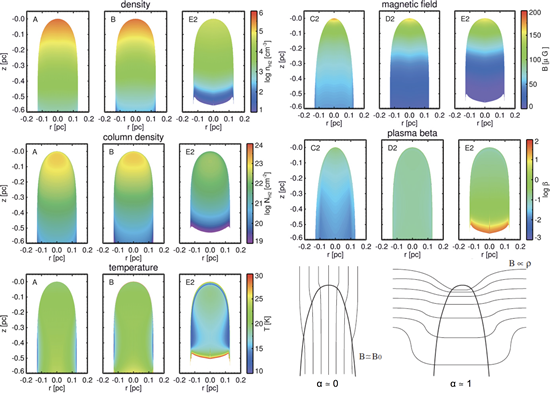Effects of Magnetic Field and Far-ultraviolet Radiation on the Structures of Bright-rimmed Clouds

Simulated results of the bright-rimmed clouds under the influence of FUV irradiation with or without the presence of magnetic field. Physical properties shown are volumetric density, column density, temperature, magnetic field, and ratio of thermal to magnetic pressures. Models A and B are without magnetic field, and A is with weak background FUV flux whereas B is with stellar FUV flux. Models C2, D2, and E2 are α = 0.25, 0.5, 0.75, respectively. α indicates the degree of field trapped in gas; in extreme cases, α ≃ 0 when field is parallel to the direction of irradiation and α ≃ 1 when being perpendicular.
The bright-rimmed cloud SFO 22 was observed with the 45 m telescope of Nobeyama Radio Observatory in the 12CO (J = 1–0), 13CO (J = 1–0), and C18O (J = 1–0) lines, where well-developed head–tail structure and small line widths were found. Such features were predicted by radiation-driven implosion models, suggesting that SFO 22 may be in a quasi-stationary equilibrium state. We compare the observed properties with those from numerical models of a photoevaporating cloud, which include effects of magnetic pressure and heating due to strong far-ultraviolet (FUV) radiation from an exciting star. The magnetic pressure may play a more important role in the density structures of bright-rimmed clouds than the thermal pressure that is enhanced by the FUV radiation. The FUV radiation can heat the cloud surface to near 30 K; however, its effect is not enough to reproduce the observed density structure of SFO 22. An initial magnetic field of 5 μG in our numerical models produces the best agreement with the observations, and its direction can affect the structures of bright-rimmed clouds.